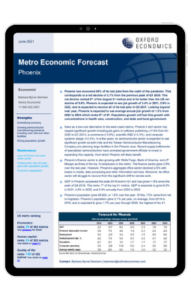US | Metro Economic Forecast: Phoenix

Phoenix has recovered 66% of its lost jobs from the nadir of the pandemic. This corresponds to a net decline of 2.7% from the previous peak of Q1 2020. This net decline ranked 6th of the largest 51 metros and is far better than the US net decline of 5.6%. Phoenix is expected to see job growth of 3.4% in 2021, 2.9% in 2022, and is expected to recover all of its lost jobs in Q3 2021. Looking beyond next year, Phoenix is expected to see average annual job growth of 1.0% from 2023 to 2025 which ranks 9th of 51. Population growth will fuel this growth with concentrations in health care, construction, and state and local government.
What you will learn:
- Seen as a low-cost alternative to the west coast metros, Phoenix’s tech sector has reaped significant growth including job gains in software publishing (+7.0% from Q1 2020 to Q1 2021), e-commerce (+5.6%), scientific R&D (+5.3%), and computer systems design (+2.4%).
- Phoenix’s finance sector is also growing with Wells Fargo, Bank of America, and JP Morgan as three of the top 10 employers in the metro. The finance sector grew 2.9% over the last year.
- GDP in Phoenix surpassed the peak 2019 level in Q1 and has grown 1.8% since the peak of Q4 2019. This ranks 7th of the top 51 metros. GDP is expected to grow 8.3% in 2021, 4.9% in 2022, and 2.0% annually from 2023 to 2025.
Tags:
Related Services

Post
The euro and depreciation – shake, shake it off
Our new forecast assumes a slower euro appreciation against the dollar over the coming years than we previously anticipated. Relative productivity, terms of trade, and the current account will likely be less supportive of the euro than we thought. In addition, a stronger stock market than initially envisaged will attract more financial flows into the US than we had expected.
Find Out More
Post
Food prices to bottom out in 2024, risks skewed to upside
Our baseline forecast is for world food commodity prices to register an annual decline this year, in aggregate, reducing pressure on food retail prices further downstream. However, we believe the risks to this forecast are overwhelmingly skewed to the upside.
Find Out More